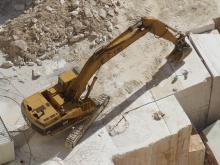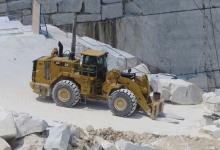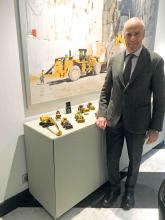
While aggregate quarries in Europe may still be recovering from the global recession, Italy's marble quarries in Carrara are seeing a good demand. Claire Symes visited Henraux's quarry to find out more
The location of
Unlike its aggregate counterparts, the marble quarry supplies customers worldwide and this large market has meant that it has remained busy through the recent financial downturn. Not only has Henraux made significant investments in equipment over the last few years but it is also opening up new reserves in a bid to meet demand.
History
Quarrying in the region can be traced back to the Roman era and stone from here has been used by many famous sculptors from the Renaissance's Michelangelo through to the 20th century artist Henry Moore.
The modern day Henraux quarry was opened in 1821 and draws its name from Frenchman Jean Baptiste Alexandre Henraux who accompanied Royal Mint and Commissary of the State Quarry director Giovanni Fabrioni on a visit to Mount Altissimo to inspect the deposits in 1820. Fabrioni described Henraux's role as "royal Superintendent to the choice and purchase of the statuary and white marbles of Carrara for the public monuments of France" and they were accompanied by a quarry chief and two English sculptors. The quarry was opened as a result of the visit by the French and the marble confiscated in lieu of war taxes that were unpaid by the City of Carrara.
The quarry initially used techniques similar to those employed by the Romans of exploiting defects - known in Italy as litocalsi - in the rock and opening them up using wedges, levers and chisels, along with gunpowder, human force and animal strength. Development of helical wire, winches, air hammers and mechanical drills enabled the quarry to be mechanised so that higher quality rock could be extracted
"Introduction of synthetic diamond in the 1970s improved production further with the addition of diamond wire machines and diamond chains that allowed blocks of 30 to 40tonnes to be extracted at a time," said Henraux managing director Paolo Carli..
Carli joined the company in 2003 when he merged his family business with that of Henraux's. Carli is a third generation quarryman in the Carrara region. "I grew up with it," he said. "My family name was well-known in the architecture world for producing high quality stone, so the merger with Henraux made sense and strengthened the operation. It was sad to see the end of the family ownership but I brought all of the workers with me to Henraux and we now have a very strong and experienced team here."
The quarry exploits the metamorphic formations of the Apuan Alps between the green shale base from the Hercynian age and the Lias marbles that outcrop between Monte Altissimo and Pizzo Cervaiole. The variable geology means that the quarry has access to a number of different deposits including: Base green shale, which is formed by quarzite muscovitiche phyllites, schists and quartzites porphyritic; Warts made up of quartzites alternating with phyllites muscovitiche; Grezzoni (dolomitic limestone that is more or less crystallized); And a variety of marbles. The marble megalodon is formed from a saccharoidal limestone and breccia, the dolomite marble is formed from dolomitic limestone alternating with light grey dolomite, while the crystalline limestone marble features white marble with medium-fine grained thin veins or spots of grey, cloudy or grey bardigliacei type marble, white marble veined with various shades and streaks of grey and white Arabescato marble.
Extraction
Stone is cut from the rock face using specialist rock saws and diamond blades. Once freed from the surrounding rock, either the excavator is used to manoeuvre the block away from the face or the wheeled loader is used directly to pick up the block before hauling it to the loading yard. The work for the machines is arduous with blocks typically weighing around 30tonnes and measuring 2.7m by 1.6m by 1.6m each being hauled up very steep slopes that wind around the compact quarry.
Cultural Development
While Henraux is supplying some of the world's highest profile construction projects, it is also keen to promote the careers of new and emerging artists. The company has a foundation that helps to fund young artists and supply them with materials too.
"The foundation is located in the original office builiding of Henraux and also features works of art that have been created by famous sculptors using material from the quarry", said Carli. "I think supporting young artists is very important. Having worked in a marble quarry all my life and seeing how it can be crafted, I have art inside me - I grew up with it."
As a result of Carli's and Henraux's interest in promoting art, the company supplied materials to Giovanni Manganelli to creat an exhibition at Pisa Airport, which is being sponsored by the quarry and Volvo Construction Equipment. The exhibition will remain at the airport through 2013 but Carli said that he hoped to find another artist to work with so the display will change during the period.
Henraux's promotion of culture extends beyond sculpture though - the quarry was hosting a private open air concert the weekend after ABE's visit to the site for 120 guests from a private bank. Carli said that the Volvo machines would form part of a display to set the scene at the event. "A German television channel also recently filmed a programme at the quarry too," he said."This demand placed on the equipment meant that Carli had to consider his options carefully before investing in new equipment. The most recent acquisitions were two wheeled loaders and a 70tonne excavator from
When it came to investing in the new equipment for the quarry, Volvo Construction Equipment was not the automatic choice for Henraux though as it is a relative newcomer in the Italian market having established distribution networks there in 2006.
We tested
"Apart from the marketing and the price, it was really the technology that convinced us to invest. Our machine operator also provided his opinion and he felt the Volvo machines offered good results." Negotiations started in 2007 and were finalised in early 2008. The first machine - a Volvo L350F wheeled loader was delivered in the spring and was followed soon after by an EC700C excavator and an L330E wheeled loader.
Delivery of the 70tonne excavator to the site required careful planning. It was brought up to the quarry's access road by a low loader - a twisting route that takes almost 40 minutes from Henraux's factory on the quarry floor by car. The final leg of the journey into the quarry had to be completed under the excavators own power and it took a whole day for the machine to climb up the final part of the route.
According to Carli, the machines are performing well and are delivering good fuel economy. Nonetheless, the work is hard and Henraux has invested in service contracts for the machines to help manage the costs and ensure availability.
Carli said that the company now has sufficient machines to meet the main quarry's needs in the next 12 months but it is likely to be looking to invest further in 2012 or 2013.
Planning
Although some areas of the quarry yield more valuable rock than others due to the veining, extraction is carried out according to the quarry's masterplan in order to ensure all economically viable material is extracted..
The quarry manages to work all year round thanks to its south facing aspect with a direct flow of humid sea air helping to keep the snowfalls to a minimum. Quarries on the north side of the mountain are not so fortunate and often have to close between December and January, with closures sometimes extending into February too.
The quarry currently operates with a team of 20 people working 39 hours a week but operating hours are extended if demand is high. A further 100 people are employed in the cutting operations at the company's factory on the valley floor. Currently the quarry is producing 12,000tonnes of stone a year but Carli is working on plans to increase this significantly in the near future.
Markets
Unlike the aggregates market, the decorative stone market did not experience a serious impact from the global recession. "We supply material worldwide and demand for white marble is strengthening," said Carli. Marble from Henraux's quarry has been used for a number of high profile projects including the new Abu Dhabi mosque and Mumbai Airport. Carli said that the company is currently tendering for a very big project in the US which is very intricate in terms of the architecture and will call for a high volume of marble too.
"Business from the Middle East was good until 2008 but demand from the US is now picking up and architecture firms appear to be busier than before," he said. "Although we are pitching for projects worldwide, most of our competitors are local to us.
Despite the demand, prices have not increased in almost 10 years. "The recession did affect prices but Chinese competition has also had an effect," said Carli. "We have moved away from landscaping and external works to focus on detailed internal projects." In order to meet the demand of these kinds of projects Henraux has invested heavily in CNC machinery and 3D computer controled technology. "We can now deliver designs with zero tolerance," said Carli. "To produce material to this standard does cost the client more and not every project calls for it." Carli said that Henraux is probably one of the only marble producers in the region that proactively develops its network of end clients and architectural contacts and credits this as the key reason for the strong demand.
Future expansion
Henraux is now opening two other quarries in the region. One of the new sites was abandoned in the 1960s and will be operated as a mine - a new venture for the company - and another is a completely new site on the north side of the mountain. "Both sites have reserves of good quality white marble with a nice fine grain," said Carli. "Opening of the new sites is part of our strategy to increase production to 30,000tonnes a year by 2013." Henraux has been working with geotechnical engineers at the University of Sienna in order to develop a method for the new mining operation and workers have been receiving training for the new techniques. Carli said that the company will be investing in rock cutting equipment from Fantini and Benetti Macchine for the new venture.
Excavators
2x Fiat-Hitachi FH400
1x Liebherr 984 Litronic
1x Volvo EC700C
1x Case 1845C "We have started to excavate the heading tunnels for the new gallery excavations and we are currently installing rock bolts in this area to secure the structure," said Carli. "It will be more expensive to operate in this way than a conventional open quarry but tunnelling gives us the possibility to follow the coloured veins of rock and also reduces the environmental impact of the operation too." Addition of the new quarries to Henraux's operations increases the company's reserves significantly and Carli estimates that there is sufficient premium quality stone for another 300 years of production at the targeted production level.









